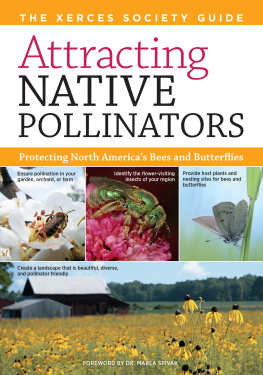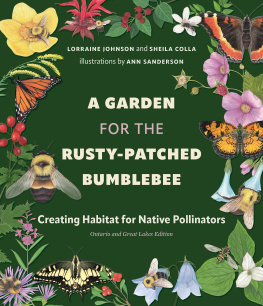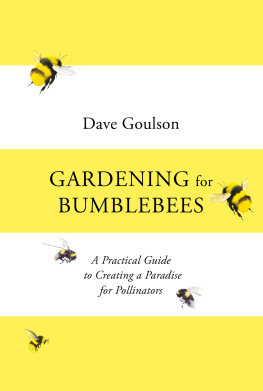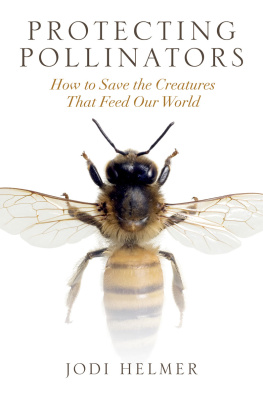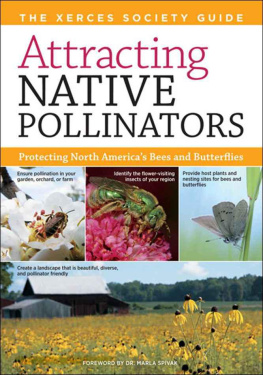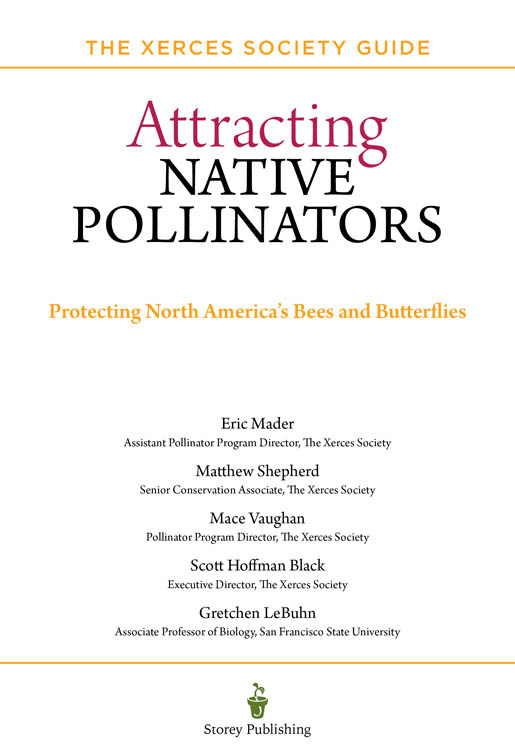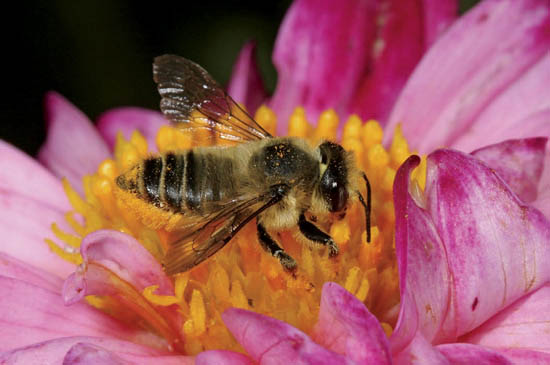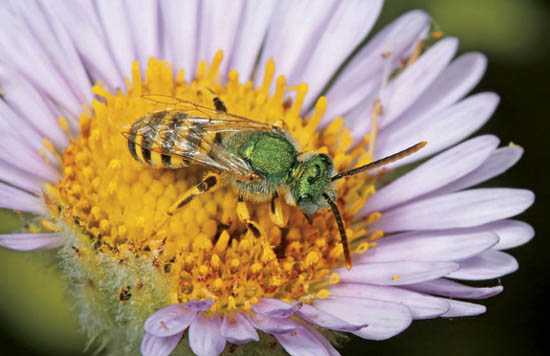The mission of Storey Publishing is to serve our customers by publishing practical information that encourages personal independence in harmony with the environment.
Edited by Deborah Burns
Art direction and book design by Cynthia N. McFarland
Text production by Liseann Karandisecky and Jennifer Jepson Smith
Front cover photography by Jim Cane, Mining bee (top left); Rollin Coville, Metallic sweat bee (top center); Rufus Isaacs, bottom; Dana Ross, Fenders Blue (top right)
Back cover photography by William Bouton, Southern dogface; Rollin Coville, Long-horned bee; Preston Scott Justis, Sachem skipper; Bruce Newhouse, Mining bee
Spine photography by Alistair Fraser
Interior photography credits appear
Illustrations by David Wysotski, Allure Illustration
Indexed by Samantha Miller
Special thanks to Mars Vilaubi (image management), Ilona Sherratt (illustration coordinator), Hartley Batchelder (prepress technician), and Elizabeth Stell (botanical editor)
2011 by The Xerces Society
Ebook version 2.0
March 18, 2016
All rights reserved. No part of this book may be reproduced without written permission from the publisher, except by a reviewer who may quote brief passages or reproduce illustrations in a review with appropriate credits; nor may any part of this book be reproduced, stored in a retrieval system, or transmitted in any form or by any means electronic, mechanical, photocopying, recording, or other without written permission from the publisher.
The information in this book is true and complete to the best of our knowledge. All recommendations are made without guarantee on the part of the author or Storey Publishing. The author and publisher disclaim any liability in connection with the use of this information.
Storey books are available for special premium and promotional uses and for customized editions. For further information, please call 1-800-793-9396.
Storey Publishing
210 MASS MoCA Way
North Adams, MA 01247
www.storey.com
LIBRARY OF CONGRESS CATALOGING-IN-PUBLICATION DATA
Attracting native pollinators / by The Xerces Society.
p. cm.
Includes index.
ISBN 978-1-60342-695-4 (pbk. : alk. paper)
1. Insect pollinators--Conservation. 2. BeesConservation.
3. Insect pollinators--Habitat. 4. Bees--Habitat. I. Xerces Society.
QL467.8.A88 2011
631.5'2dc22
2010043054
FOREWORD
THIS BOOK IS MUCH MORE THAN A RESOURCE on how to improve habitat for native pollinators. It is a step-by-step guide for changing our stewardship of the earth; it is a tangible way for people of all ages to make a difference. Active participation in this vital, grass-roots revolution is easy: Plant flowers. Sure, by creating floral and nesting habitat, bees, butterflies, and countless other wildlife species will prosper. But through this same simple effort, you will be ensuring an abundance of locally grown, nutritious fruits and vegetables. You will beautify our cities, roadways, and countryside. You will be helping to spread the word about the urgent need to reduce pesticide use, while at the same time creating habitat for beneficial insects that prey upon crop pests. You will be increasing natural diversity and ecological resilience through pollinator gardens, bee pastures, and flowering field borders that stabilize the soil, filter water runoff, and pack carbon into the roots of native prairie plants. For many of our earths current environmental ills, you will be part of the solution.
Dr. Marla Spivak
Professor of Apiculture and Social Insects
2010 MacArthur Fellow
University of Minnesota
ACKNOWLEDGMENTS
THE AUTHORS WOULD LIKE TO THANK their families and friends for providing the countless words of encouragement and endless patience throughout long hours of writing and revision. The best parts of this book are a reflection of their support. They also wish to thank Lisa Schonberg for helping develop the bee profiles in the , Dr. Claire Kremen, Katharina Ullmann, Jessa Guisse, Jennifer Hopwood, Dr. Robbin Thorp, Dr. Neal Williams, Dr. Lora Morandin, Dr. Rachael Winfree, Dr. Marla Spivak, Elaine Evans, Dr. Rufus Isaacs, Dr. David Biddinger, Dr. Jaret Daniels, the many dedicated biologists and conservationists of the USDA Natural Resources Conservation Service, especially Wendell Gilgert, and finally the fantastic staff and individual members of the Xerces Society.
CONTENTS
PREFACE A New World
FOR EACH OF THE AUTHORS of this book, studying pollinators and creating habitat opened up a new world. We have all been captured by the play that unfolds across a floral stage, waking up one morning to discover male long-horned bees fast asleep in a sunflower, or getting caught up in the intense buzz and energy of a thousand bees in a blooming native basswood tree. Weve been surprised to discover bees nesting in unexpected places: wrapped in pink petals under a flowerpot, emerging from tiny holes in a soccer field, or suddenly colonizing the exposed soil in a weeded flower bed. Weve been deeply satisfied to watch a leafcutter bee return to a newly mounted bee block with an impossibly big piece of leaf, or a mason bee return with a belly dusted bright orange with pollen. Weve stopped and smiled at seeing a flower patch alive with insects.
The delight of this intimate connection with some of natures most important and hardest workers awaits you. This book will help you get there.
Attracting Native Pollinators is a comprehensive guide to assist gardeners, farmers, educators, park managers, golf course superintendents, and public land managers in understanding, providing, enhancing, and managing habitat for pollinating insects. It focuses on North America, but most of the concepts apply to any of the temperate areas of the world. Using this book as a guide, your efforts on behalf of pollinators will, in turn, help support bountiful harvests on farms and gardens, maintain healthy plant communities in wild lands, provide food for other wildlife, and beautify your landscape with flowers.
Here you will find practical and specific information on how to establish flower-rich foraging patches and nesting sites for pollinating insects any place where there is space enough for a few plants, whether its a backyard patio in Bangor, Maine, a community garden in New York City, a golf course in the Chicago suburbs, school grounds in Birmingham, Alabama, or a farm in rural California.
This book also includes information on the life history of pollinating insects found in North America, a pictorial guide to native bees, and regional lists of plants that support bees or serve as host plants for butterflies. There are detailed instructions for designing pollinator gardens and habitat, as well as the creation and management of nesting structures for native bees, plus educational activities for children and an extensive list of resources. In short, everything you need to understand pollinating insectsfrom bees to butterflies, moths, flies, and beetlesand to provide them with food and shelter is here in one book.

